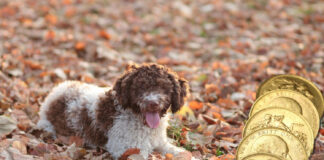One of the largest, richest and most beautiful gold treasures in Danish history so far has just been unearthed in Vindelev, near Jelling, Denmark. The enormous find of almost 1 kg of gold, including some huge medallions the size of saucers, has again seen the light of day, after 1,500 years in the Danish soil.
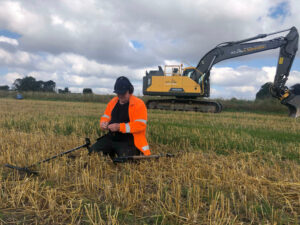
Ole Ginnerup Schytz had just acquired a metal detector and had been given permission to walk on land belonging to his old classmate. In December 2020, after a few hours, he found one of the greatest gold treasures in Danish history. The site was subsequently excavated by archaeologists from Vejlemuseerne, in collaboration with experts from the National Museum and with funding from the Agency for Culture and Palaces.
Archaeologists now know that the treasure was buried in a longhouse in a village about 1,500 years ago. The studies, and the many samples and data collected, will provide invaluable knowledge about the connections and circumstances that led to the treasure being buried by an Iron Age chieftain.

A Chieftain in Vindelev
The discovery of the enormous amount of gold shows that Vindelev was a center of power in the late Iron Age. “Only a member of the absolute cream of society would have been able to collect a treasure like the one found here”, explains Head of Research at Vejlemuseerne, Mads Ravn, and continues: “Although the name Vindelev, can be linked to the time of migration, there was nothing that indicated that previously unknown warlord or chieftain lived here, long before the kingdom of Denmark arose in the following centuries.”
Here, just under 8 km from Jelling, which in the 10th century became Denmark’s cradle, there was a powerful Iron Age chieftain in the 6th century who managed to create wealth and attract skilled artisans. For unknown reasons, he chose to bury this large gold hoard. Perhaps to save it in case of war, or perhaps as a sacrifice to the higher powers.
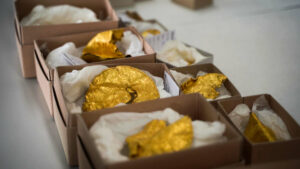
Mythological Motives and a Roman Emperor
The Vindelev Hoard consists of saucer-sized, beautifully decorated medallions, so-called bracteates. There are also Roman coins that have been made into jewelry. They occur in a combination and with techniques of which comparable examples have never been seen. Therefore, experts describe the quality of this find as unique.

Some of the objects have motifs and runic inscriptions that may refer to the rulers of the time, but also, according to some of the researchers who have so far had the opportunity to examine the treasure, may refer to Norse mythology.

One of the finds is a bracteate that has a male head with a braid and a number of runes on it. Under the head, a horse is seen and a bird with which the man communicates. There is a runic inscription between the horse’s muzzle and forelegs, which according to the preliminary interpretations says “houaʀ”; “the high one”. “The High One” may refer to the ruler who buried the find, but in later mythological contexts is also a term associated with the god Odin.
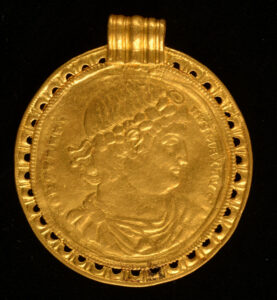
There are also much older coins from the Roman Empire. Most notably a heavy gold coin from the Roman emperor Constantine the Great (285-337 AD). Constantine legalized Christianity among the Romans in AD 313, a few hundred years before the coin that bears his face found its resting place in Vindelev under a Danish longhouse, 2,000 km further north. The fascinating journey of the gold tells us about a European continent that already in the Iron Age was closely connected by trade and war.
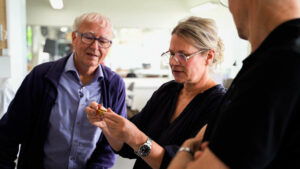
A Chaotic Time
Many of Scandinavia’s largest gold finds date from the middle of the 5th century, when the ash cloud from a large volcanic eruption in the year AD 536 created a global climate catastrophe with many years of crop failure and famine. Preliminary dates suggest that the treasure was buried at this chaotic time in world history. A couple of years ago, the archaeologists from Vejlemuseerne excavated another gold treasure from this period on the small island of Hjarnø in Horsens fjord. According to many researchers, the climate catastrophe in AD 536 caused the inhabitants of what is now Denmark to reject the old rulers and bury lots of gold during this period. Maybe to save it from enemies, or maybe to appease the gods. Some researchers believe that the foundation of the Viking Age society, and a united Danish kingdom, lies in this period. To this day, more than 40 kg of gold from the Iron Age have been found. The size, quantity and technical details of the objects in the hoard found in Vindelev just outside Jelling, are completely unique, placing the find in the absolute top.

To Be Exhibited Next Year
In less than six months, the Vindelev Hoard can be viewed as part of Vejlemuseerne’s large Viking exhibition, which opens on 3rd February 2022. The exhibition tells the story of Harald Bluetooth’s Eastern connections and alliances, and the formation of the early Danish kingdom that created the foundation for the Jelling dynasty. The exhibition is a collaboration with Moesgaard Museum, which will have an exhibition about other aspects of the Vikings’ travels to the east.
Read more about coin hoards and their circumstances.
Do you already know the coin cabinet of the National Museum of Denmark?
View this short video (in danish) with further information about the discovery of the treasure:






